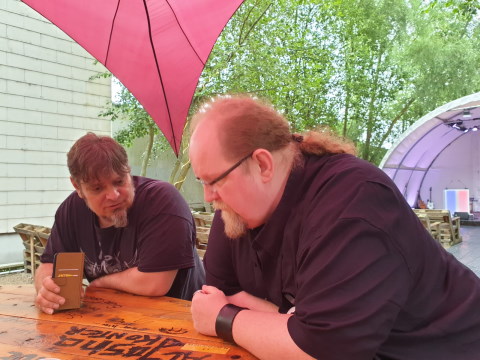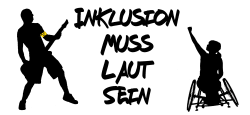Inklusion Muss Laut Sein
How to make inclusion a success at festivals
In addition, I act as a lifeline whenever the consulting service of another “expert” was incomplete or even completely wrong. I would like to give you some knowledge with a few examples so that you can recognize whether you are getting serious advice or hot air.
How to make inclusion a success at festivals – Is complete accessibility even possible?
In my day-to-day consulting work, I hear phrases like “We’re already completely barrier-free” or “We’ve already implemented everything we found on the Internet” and also popular “We had an expert on the team for that” – then congratulations, so your festival doesn’t need any further consulting. The question is, why are you contacting me?

In a personal preliminary discussion, it quickly becomes clear that there are some problems and that inclusion, accessibility or participation at this event have been poorly understood or implemented. The question “Is complete accessibility even possible?” should the so-called “expert” you basically answer with a No. Most consultants and advisors always speak of accessibility when a festival is more or less accessible by wheelchair. But this statement is wrong, because wheelchair users are only a part of the people at a festival. In addition, there are other factors that must be included in accessibility.
Why then tackle accessibility if 100% is not achievable? As I already mentioned, the answer to the question of complete accessibility is no, if you want to work seriously. This is due to several factors over which you have no control and also to the individual sensibilities of your guests. In principle, you can make all events inclusive and accessible to a very large group of people.
Aktion Mensch defines its view of the term accessibility as follows:
“Inclusion does not work without accessibility. Where places, spaces or means of communication are not barrier-free, participation in cultural and political life, in the world of work and in leisure time is denied. But what exactly does accessibility mean?
Most people understand accessibility to mean ramps instead of stairs, wide doors and lowerable buses. But structural changes and specially equipped vehicles are not enough to make everyday life barrier-free. Accessibility means that buildings and public places, workplaces and homes, means of transport and commodities, services and leisure facilities are designed so that they are accessible to all without outside help. In concrete terms, accessibility therefore means that not only steps but also an elevator or ramp lead into the town hall, that forms are not available in complicated official language but also in plain language, and that deaf people can also follow a lecture – for example with the help of a sign language interpreter. In addition, digital accessibility must also be considered in the definition. This means that websites must be designed in such a way that everyone can use them. This includes, for example, providing image descriptions for blind people and the ability to play videos in accessible formats.”
How to make inclusion a success at festivals – Once the standard please…
“I would like to have a standard list that I can easily work off” so or so similar sound requests in practice and Yes there are inclusion sites that offer such lists. However, I would like to note two things about this, such a list should only serve as an orientation and not as a concept. Secondly, you need to question yourself if your festival is standard. Every festival, every event is a very individual story. Basically, it is nice if you think about accessibility and want to address this issue at your events.
It should be clear to you, however, that every festival is different, and a wide variety of factors play a role here as well. For example, the terrain or the venue is important, what requirements do your visitors have of your event, or even what measures have already been taken. Are the measures taken at all useful or are they not accepted by your guests.
As a tip I can give you, look for a standard list as a guide and approach the individual points piece by piece with the knowledge of your festival. When it comes to a concrete consultation, you have a rough overview and a concept can be created better. Preliminary work facilitates the implementation and saves you time and money.
The mobilista site notes the following in a guide for wheelchair users:
“Disability is no reason not to have fun in life. And even wheelchair users want to get out in the fresh air once in a while and do what everyone else does. Most hurdles in everyday life are well known – curbs, cobblestones, stairs, non-functioning elevators and other traps await wheelchair users on a daily basis. But what about festivals? Is it possible to visit a festival or other open air events with a wheelchair? First of all: yes.
Basically, a wheelchair is not an obstacle to participate in a festival. However, limits are set here – sometimes quite narrow. Blanket statements about wheelchair accessibility are impossible – too many individual requirements and too many individual efforts by organizers to make their festival wheelchair accessible get in the way here.”
How to make inclusion a success at festivals – The expert says…
“Our consultant said…” – yes that’s how it is with consultants and advisors, they say a lot when the day is long. A consultation should be done in several steps. A serious expert will go these. This clearly includes a preliminary meeting, so that both sides can get to know each other. In the next step the collection of the ACTUAL state with an inspection of the terrain, the hall or the location. Creation of a work concept with open questions and a task definition, as well as an implementation plan for the practice. Control of all measures in the current operation and a follow-up discussion after your festival. From this the further way for the coming year is derived.
Here, too, I would like to give you a tip: investing in quality is always better than having to pay several times over or having to rework forever. Don’t get stuck on a “remote diagnosis”, because without being on site and without knowing your audience, no quality advice is possible.
How to make inclusion a success at festivals – fans with disabilities as experts?
Visitors and attendees with a disability are, by principle, experts in their own right. But that doesn’t mean they know everything for your event in terms of their disability. They speak for an individual point of view, that is, from their personal perception in terms of accessibility and accessibility. Just because someone uses a wheelchair does not automatically make him or her the benchmark for accessibility. What matters here is how long someone has been using his or her wheelchair, for example, or is blind or has some other disability. It makes a difference whether someone is skilled or not. The important thing is that you work together with your guests and don’t rely on one person’s judgment.
So if you want to know more about your festival and have an expert knowledge of accessibility, don’t ask a guest or “experts” brought by the consultant, but offer your guests the opportunity to actively participate. Inclusion and accessibility live from the active cooperation of the many. From this knowledge, you can then deduce where the weak points are at your festival.
As a practical tip, be sure to involve your guests; it’s important that hints and tips are noticed and appreciated. The key to an accessible event lies in the experiences of visitors and attendees. I’ll be happy to show you how such a process works and how you can achieve more for inclusion together with your guests.
How to make inclusion a success at festivals – The first step…
Is always the hardest, but also the most meaningful. You took the time to read up on “How to Make Inclusion a Success at Festivals.” This was the first step on your way to an inclusive festival for all guests. Inclusion and accessibility are not a luxury, but a profitable and sustainable thing. You are addressing new target groups for your festival and are doing something that is far from being a matter of course.
Now it’s time to stay on the ball, keep yourself informed and initiate processes so that we can all celebrate together. I will regularly give you tips on how to make inclusion at festivals a success. We’re scratching the surface here, but your festival will still benefit from these tips. Should you want to get serious about inclusion and accessibility, feel free to contact me for a preliminary discussion.
A quick note, Inclusion Must Be Loud offers you as an organizer an added value to your event. Therefore, you should consider donating something for this knowledge. Donations enable the participation of fans with a disability through a BUDDIE escort perhaps to your festival.
– LOUD – LOUDER – NEWS from
The most social news from the areas of inclusion, participation, consulting, events, festivals, engagement and innovations. Independent through your donation!
